IBM & Lenovo: Analyzing Post-Acquisition Cultural Integration
VerifiedAdded on 2023/06/11
|19
|4886
|477
Report
AI Summary
This report examines the integration between IBM and Lenovo in 2005, focusing on the cultural challenges that arose post-acquisition. It begins with an overview of both organizations, highlighting their respective organizational cultures and business objectives. The report identifies language barriers and cultural clashes as significant issues, supported by theoretical frameworks such as power distance and high/low context communication. Key problems include ineffective communication, leadership issues, and added costs due to quality control failures. The report concludes with recommendations for Lenovo to improve cross-cultural communication, foster better leadership practices, and align quality standards to ensure smoother integration and business continuity. Desklib provides this and other solved assignments to aid students in their studies.
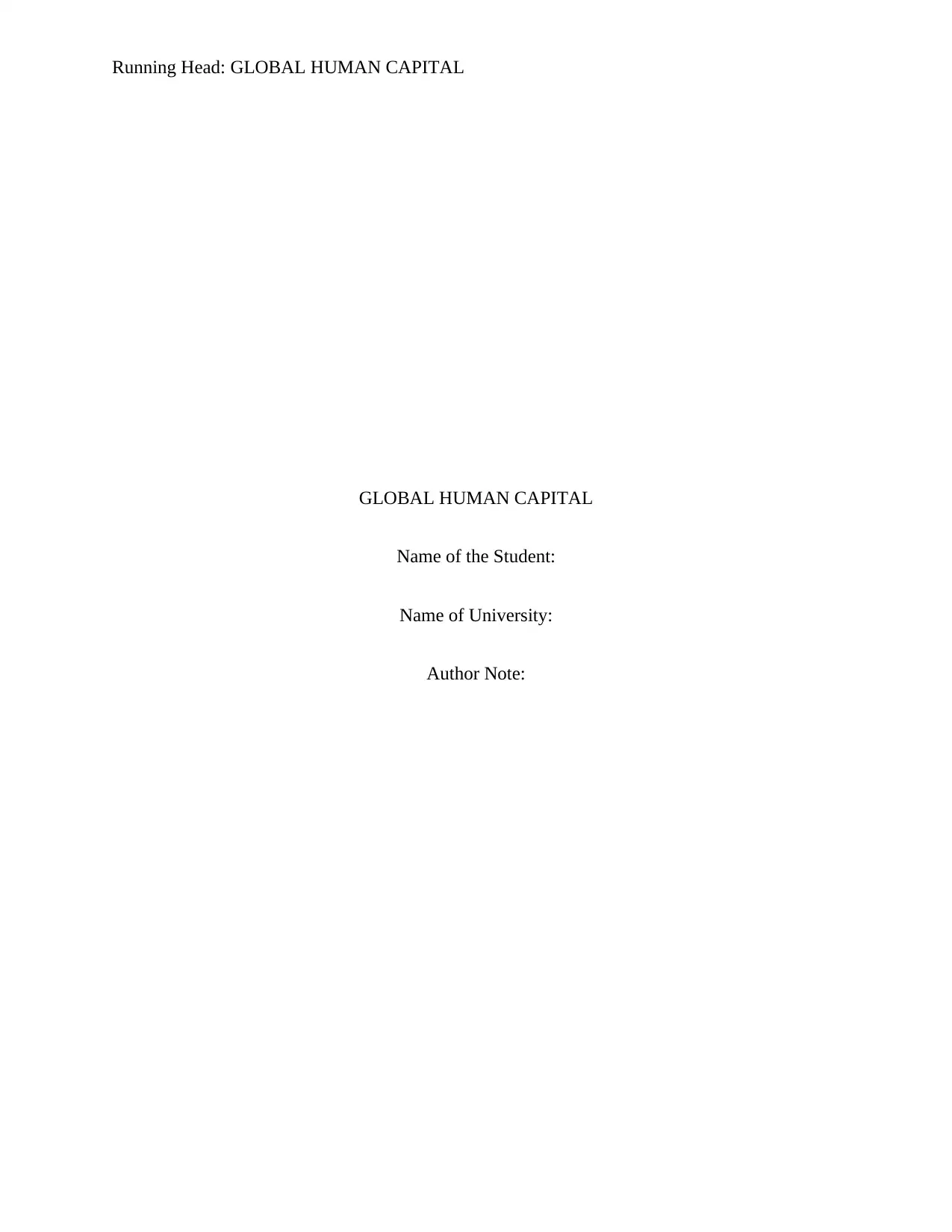
Running Head: GLOBAL HUMAN CAPITAL
GLOBAL HUMAN CAPITAL
Name of the Student:
Name of University:
Author Note:
GLOBAL HUMAN CAPITAL
Name of the Student:
Name of University:
Author Note:
Paraphrase This Document
Need a fresh take? Get an instant paraphrase of this document with our AI Paraphraser
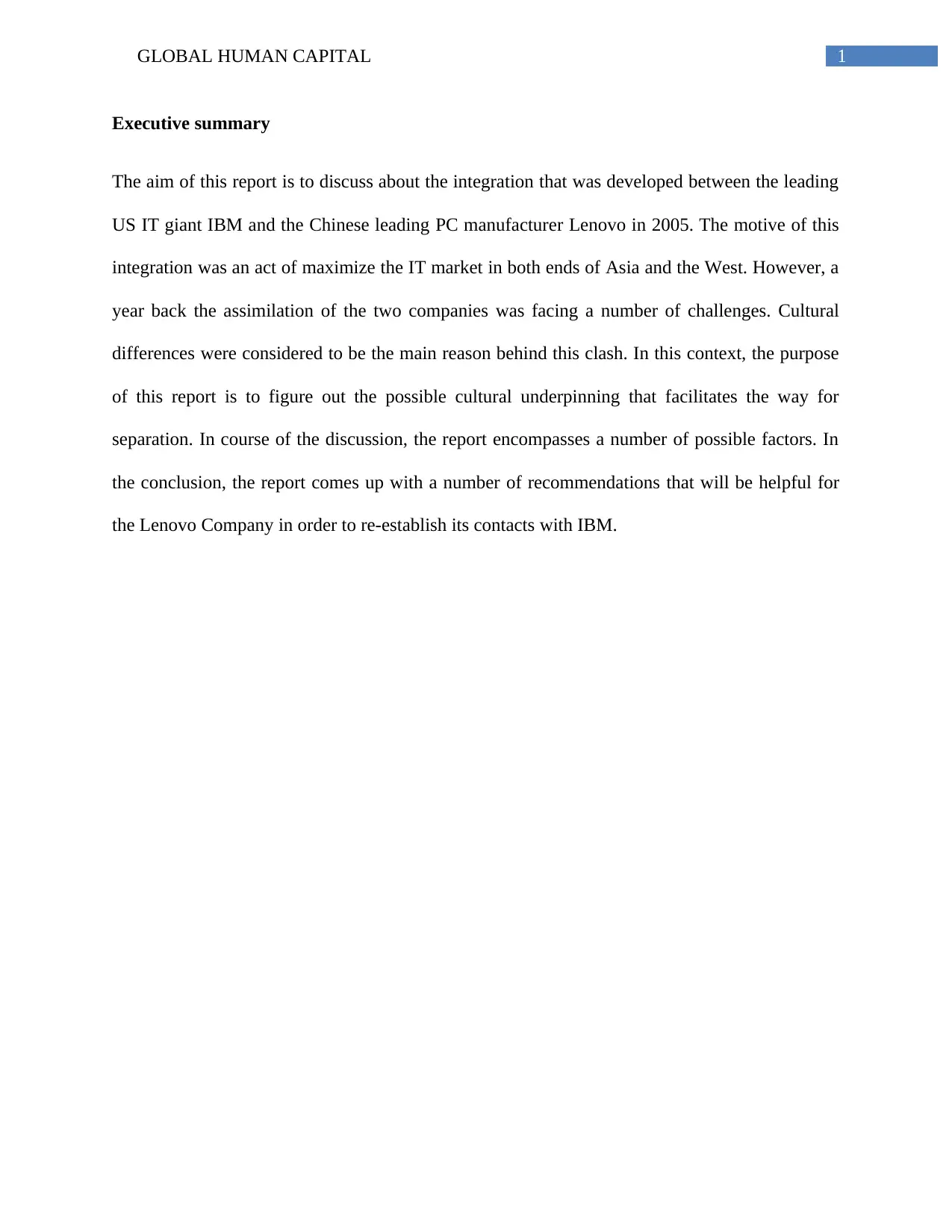
1GLOBAL HUMAN CAPITAL
Executive summary
The aim of this report is to discuss about the integration that was developed between the leading
US IT giant IBM and the Chinese leading PC manufacturer Lenovo in 2005. The motive of this
integration was an act of maximize the IT market in both ends of Asia and the West. However, a
year back the assimilation of the two companies was facing a number of challenges. Cultural
differences were considered to be the main reason behind this clash. In this context, the purpose
of this report is to figure out the possible cultural underpinning that facilitates the way for
separation. In course of the discussion, the report encompasses a number of possible factors. In
the conclusion, the report comes up with a number of recommendations that will be helpful for
the Lenovo Company in order to re-establish its contacts with IBM.
Executive summary
The aim of this report is to discuss about the integration that was developed between the leading
US IT giant IBM and the Chinese leading PC manufacturer Lenovo in 2005. The motive of this
integration was an act of maximize the IT market in both ends of Asia and the West. However, a
year back the assimilation of the two companies was facing a number of challenges. Cultural
differences were considered to be the main reason behind this clash. In this context, the purpose
of this report is to figure out the possible cultural underpinning that facilitates the way for
separation. In course of the discussion, the report encompasses a number of possible factors. In
the conclusion, the report comes up with a number of recommendations that will be helpful for
the Lenovo Company in order to re-establish its contacts with IBM.
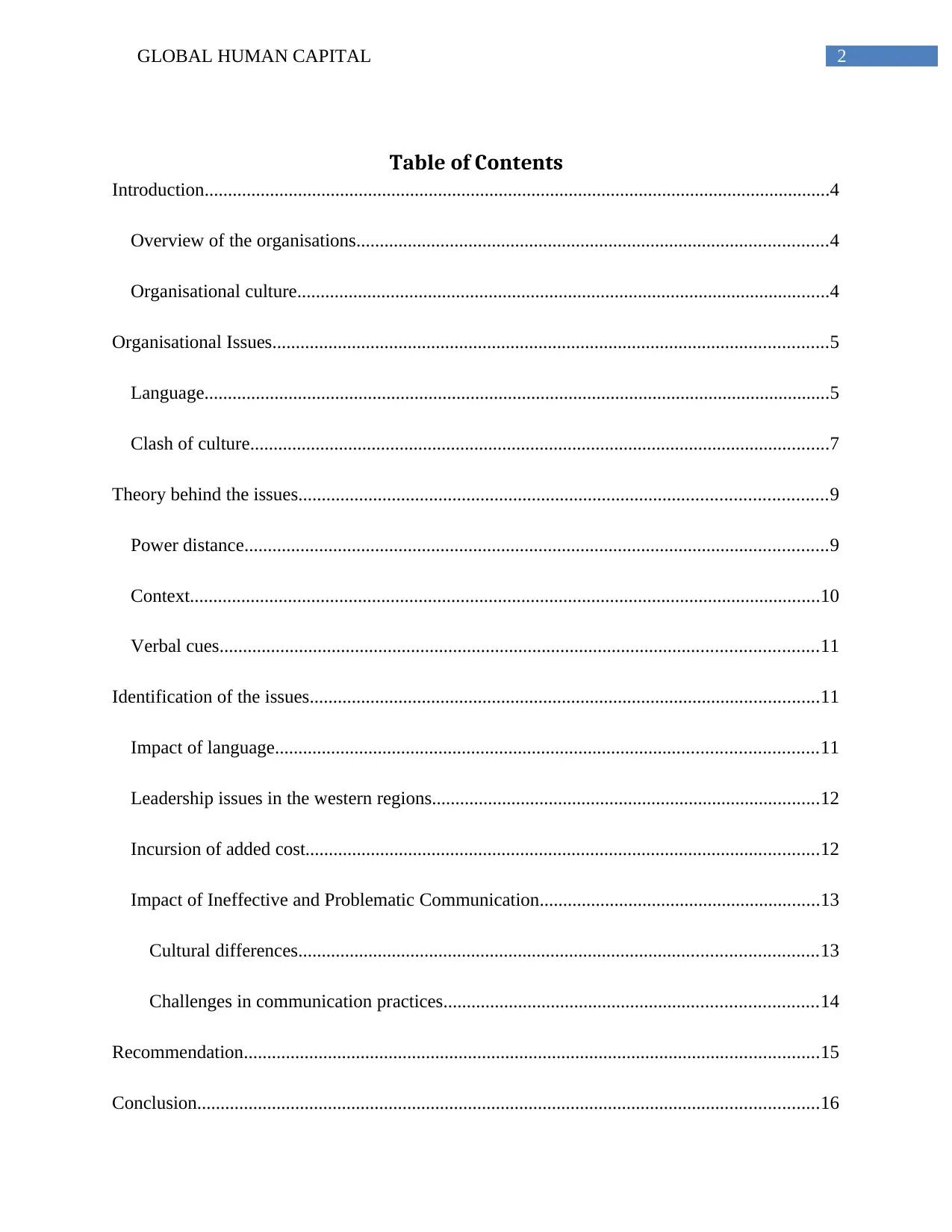
2GLOBAL HUMAN CAPITAL
Table of Contents
Introduction......................................................................................................................................4
Overview of the organisations.....................................................................................................4
Organisational culture..................................................................................................................4
Organisational Issues.......................................................................................................................5
Language......................................................................................................................................5
Clash of culture............................................................................................................................7
Theory behind the issues.................................................................................................................9
Power distance.............................................................................................................................9
Context.......................................................................................................................................10
Verbal cues................................................................................................................................11
Identification of the issues.............................................................................................................11
Impact of language....................................................................................................................11
Leadership issues in the western regions...................................................................................12
Incursion of added cost..............................................................................................................12
Impact of Ineffective and Problematic Communication............................................................13
Cultural differences...............................................................................................................13
Challenges in communication practices................................................................................14
Recommendation...........................................................................................................................15
Conclusion.....................................................................................................................................16
Table of Contents
Introduction......................................................................................................................................4
Overview of the organisations.....................................................................................................4
Organisational culture..................................................................................................................4
Organisational Issues.......................................................................................................................5
Language......................................................................................................................................5
Clash of culture............................................................................................................................7
Theory behind the issues.................................................................................................................9
Power distance.............................................................................................................................9
Context.......................................................................................................................................10
Verbal cues................................................................................................................................11
Identification of the issues.............................................................................................................11
Impact of language....................................................................................................................11
Leadership issues in the western regions...................................................................................12
Incursion of added cost..............................................................................................................12
Impact of Ineffective and Problematic Communication............................................................13
Cultural differences...............................................................................................................13
Challenges in communication practices................................................................................14
Recommendation...........................................................................................................................15
Conclusion.....................................................................................................................................16
⊘ This is a preview!⊘
Do you want full access?
Subscribe today to unlock all pages.

Trusted by 1+ million students worldwide

3GLOBAL HUMAN CAPITAL
Reference.......................................................................................................................................18
Reference.......................................................................................................................................18
Paraphrase This Document
Need a fresh take? Get an instant paraphrase of this document with our AI Paraphraser
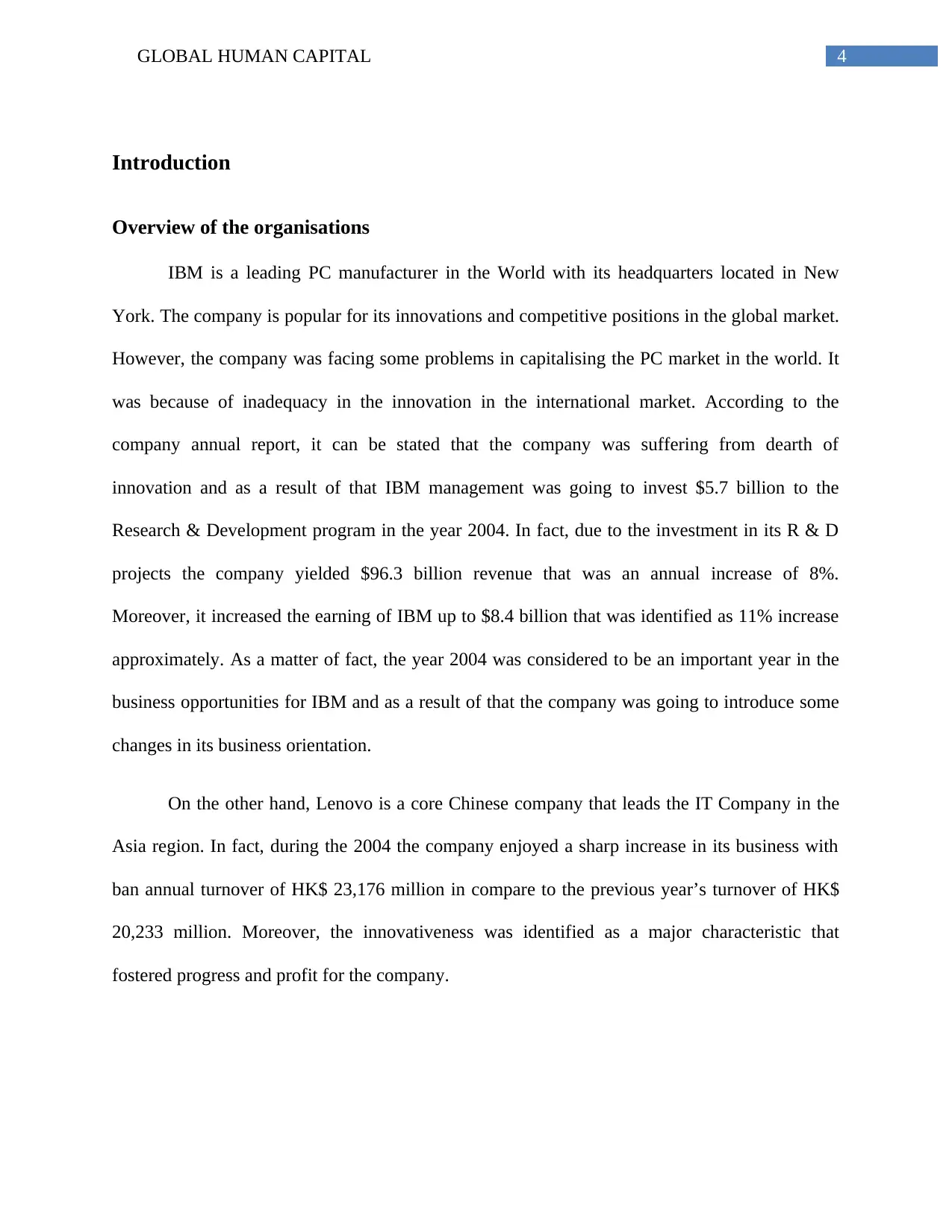
4GLOBAL HUMAN CAPITAL
Introduction
Overview of the organisations
IBM is a leading PC manufacturer in the World with its headquarters located in New
York. The company is popular for its innovations and competitive positions in the global market.
However, the company was facing some problems in capitalising the PC market in the world. It
was because of inadequacy in the innovation in the international market. According to the
company annual report, it can be stated that the company was suffering from dearth of
innovation and as a result of that IBM management was going to invest $5.7 billion to the
Research & Development program in the year 2004. In fact, due to the investment in its R & D
projects the company yielded $96.3 billion revenue that was an annual increase of 8%.
Moreover, it increased the earning of IBM up to $8.4 billion that was identified as 11% increase
approximately. As a matter of fact, the year 2004 was considered to be an important year in the
business opportunities for IBM and as a result of that the company was going to introduce some
changes in its business orientation.
On the other hand, Lenovo is a core Chinese company that leads the IT Company in the
Asia region. In fact, during the 2004 the company enjoyed a sharp increase in its business with
ban annual turnover of HK$ 23,176 million in compare to the previous year’s turnover of HK$
20,233 million. Moreover, the innovativeness was identified as a major characteristic that
fostered progress and profit for the company.
Introduction
Overview of the organisations
IBM is a leading PC manufacturer in the World with its headquarters located in New
York. The company is popular for its innovations and competitive positions in the global market.
However, the company was facing some problems in capitalising the PC market in the world. It
was because of inadequacy in the innovation in the international market. According to the
company annual report, it can be stated that the company was suffering from dearth of
innovation and as a result of that IBM management was going to invest $5.7 billion to the
Research & Development program in the year 2004. In fact, due to the investment in its R & D
projects the company yielded $96.3 billion revenue that was an annual increase of 8%.
Moreover, it increased the earning of IBM up to $8.4 billion that was identified as 11% increase
approximately. As a matter of fact, the year 2004 was considered to be an important year in the
business opportunities for IBM and as a result of that the company was going to introduce some
changes in its business orientation.
On the other hand, Lenovo is a core Chinese company that leads the IT Company in the
Asia region. In fact, during the 2004 the company enjoyed a sharp increase in its business with
ban annual turnover of HK$ 23,176 million in compare to the previous year’s turnover of HK$
20,233 million. Moreover, the innovativeness was identified as a major characteristic that
fostered progress and profit for the company.
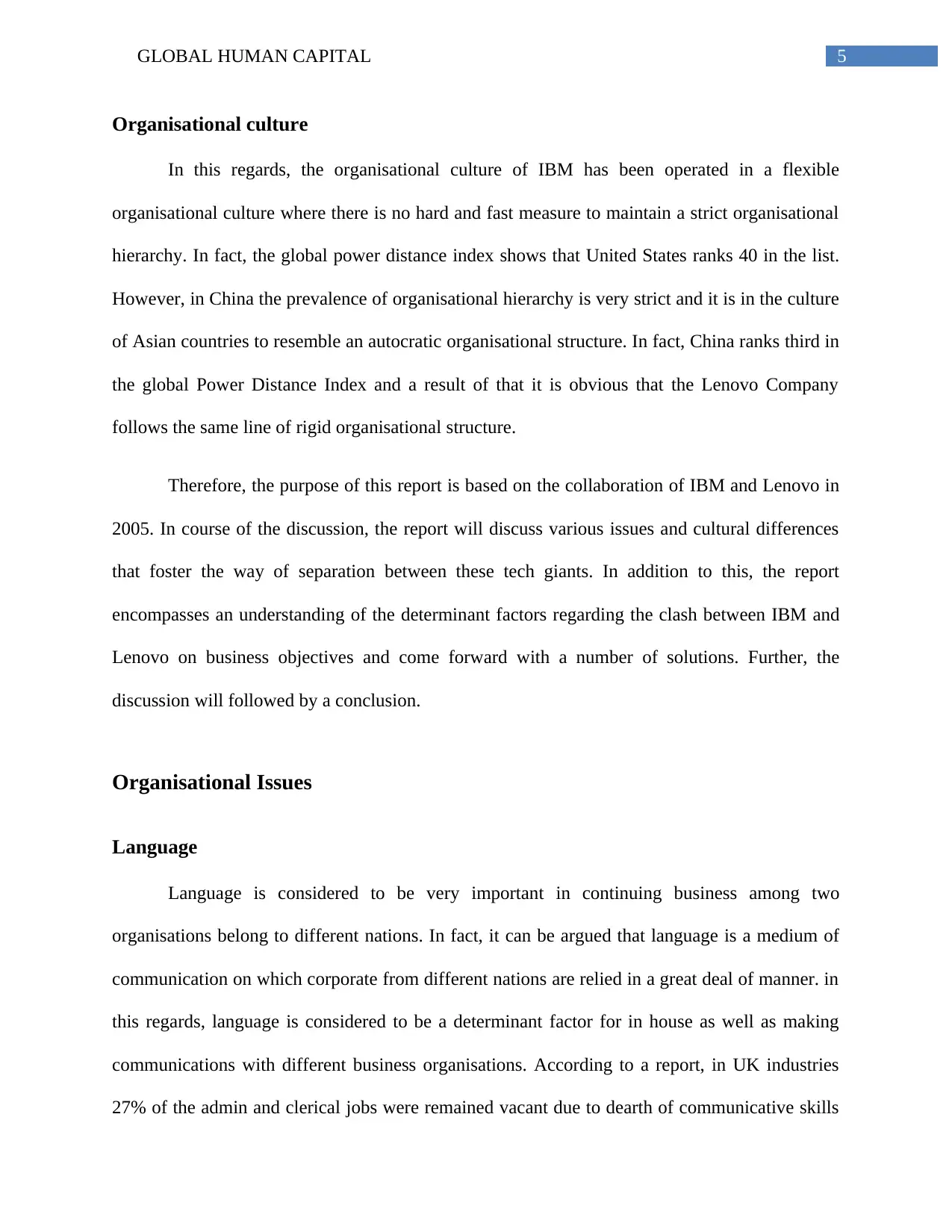
5GLOBAL HUMAN CAPITAL
Organisational culture
In this regards, the organisational culture of IBM has been operated in a flexible
organisational culture where there is no hard and fast measure to maintain a strict organisational
hierarchy. In fact, the global power distance index shows that United States ranks 40 in the list.
However, in China the prevalence of organisational hierarchy is very strict and it is in the culture
of Asian countries to resemble an autocratic organisational structure. In fact, China ranks third in
the global Power Distance Index and a result of that it is obvious that the Lenovo Company
follows the same line of rigid organisational structure.
Therefore, the purpose of this report is based on the collaboration of IBM and Lenovo in
2005. In course of the discussion, the report will discuss various issues and cultural differences
that foster the way of separation between these tech giants. In addition to this, the report
encompasses an understanding of the determinant factors regarding the clash between IBM and
Lenovo on business objectives and come forward with a number of solutions. Further, the
discussion will followed by a conclusion.
Organisational Issues
Language
Language is considered to be very important in continuing business among two
organisations belong to different nations. In fact, it can be argued that language is a medium of
communication on which corporate from different nations are relied in a great deal of manner. in
this regards, language is considered to be a determinant factor for in house as well as making
communications with different business organisations. According to a report, in UK industries
27% of the admin and clerical jobs were remained vacant due to dearth of communicative skills
Organisational culture
In this regards, the organisational culture of IBM has been operated in a flexible
organisational culture where there is no hard and fast measure to maintain a strict organisational
hierarchy. In fact, the global power distance index shows that United States ranks 40 in the list.
However, in China the prevalence of organisational hierarchy is very strict and it is in the culture
of Asian countries to resemble an autocratic organisational structure. In fact, China ranks third in
the global Power Distance Index and a result of that it is obvious that the Lenovo Company
follows the same line of rigid organisational structure.
Therefore, the purpose of this report is based on the collaboration of IBM and Lenovo in
2005. In course of the discussion, the report will discuss various issues and cultural differences
that foster the way of separation between these tech giants. In addition to this, the report
encompasses an understanding of the determinant factors regarding the clash between IBM and
Lenovo on business objectives and come forward with a number of solutions. Further, the
discussion will followed by a conclusion.
Organisational Issues
Language
Language is considered to be very important in continuing business among two
organisations belong to different nations. In fact, it can be argued that language is a medium of
communication on which corporate from different nations are relied in a great deal of manner. in
this regards, language is considered to be a determinant factor for in house as well as making
communications with different business organisations. According to a report, in UK industries
27% of the admin and clerical jobs were remained vacant due to dearth of communicative skills
⊘ This is a preview!⊘
Do you want full access?
Subscribe today to unlock all pages.

Trusted by 1+ million students worldwide
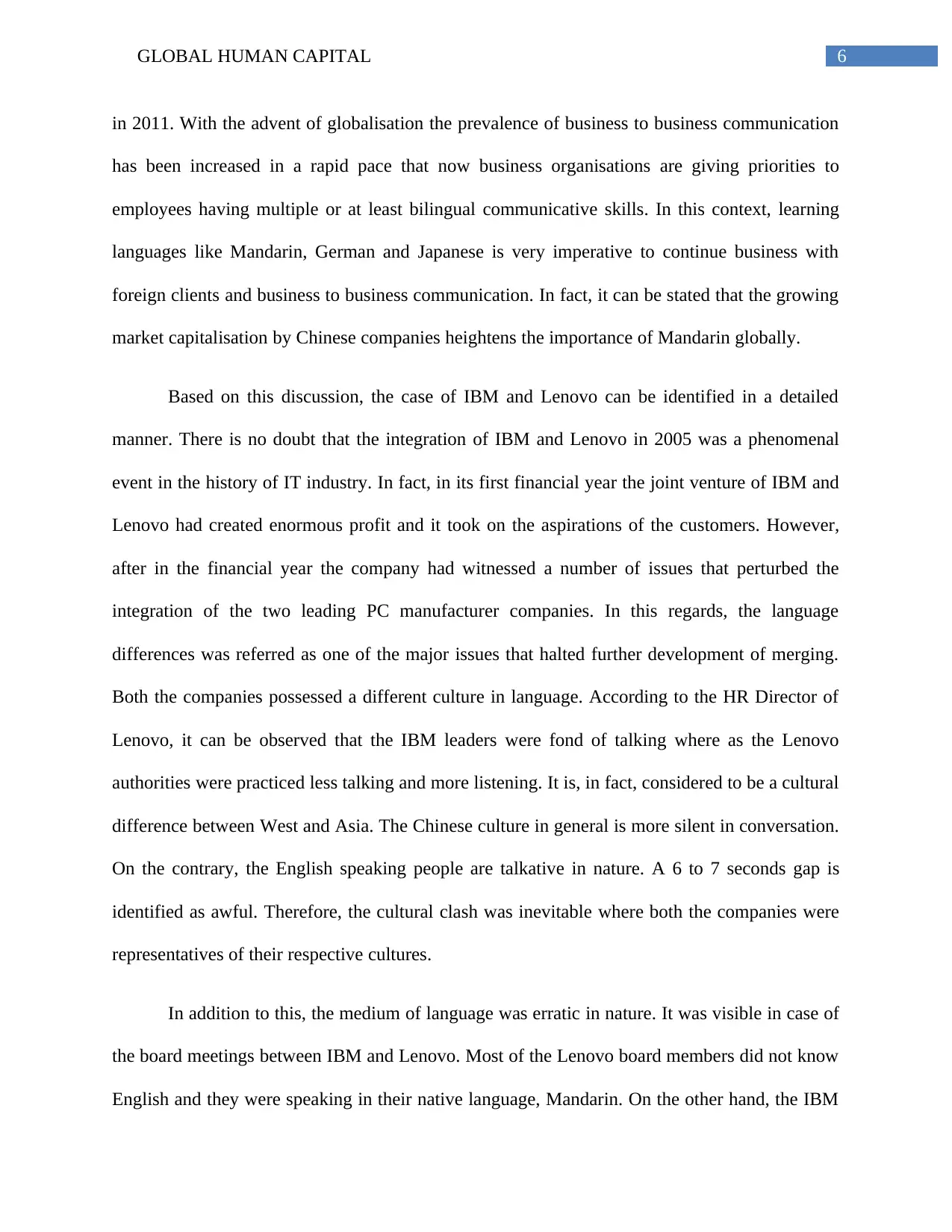
6GLOBAL HUMAN CAPITAL
in 2011. With the advent of globalisation the prevalence of business to business communication
has been increased in a rapid pace that now business organisations are giving priorities to
employees having multiple or at least bilingual communicative skills. In this context, learning
languages like Mandarin, German and Japanese is very imperative to continue business with
foreign clients and business to business communication. In fact, it can be stated that the growing
market capitalisation by Chinese companies heightens the importance of Mandarin globally.
Based on this discussion, the case of IBM and Lenovo can be identified in a detailed
manner. There is no doubt that the integration of IBM and Lenovo in 2005 was a phenomenal
event in the history of IT industry. In fact, in its first financial year the joint venture of IBM and
Lenovo had created enormous profit and it took on the aspirations of the customers. However,
after in the financial year the company had witnessed a number of issues that perturbed the
integration of the two leading PC manufacturer companies. In this regards, the language
differences was referred as one of the major issues that halted further development of merging.
Both the companies possessed a different culture in language. According to the HR Director of
Lenovo, it can be observed that the IBM leaders were fond of talking where as the Lenovo
authorities were practiced less talking and more listening. It is, in fact, considered to be a cultural
difference between West and Asia. The Chinese culture in general is more silent in conversation.
On the contrary, the English speaking people are talkative in nature. A 6 to 7 seconds gap is
identified as awful. Therefore, the cultural clash was inevitable where both the companies were
representatives of their respective cultures.
In addition to this, the medium of language was erratic in nature. It was visible in case of
the board meetings between IBM and Lenovo. Most of the Lenovo board members did not know
English and they were speaking in their native language, Mandarin. On the other hand, the IBM
in 2011. With the advent of globalisation the prevalence of business to business communication
has been increased in a rapid pace that now business organisations are giving priorities to
employees having multiple or at least bilingual communicative skills. In this context, learning
languages like Mandarin, German and Japanese is very imperative to continue business with
foreign clients and business to business communication. In fact, it can be stated that the growing
market capitalisation by Chinese companies heightens the importance of Mandarin globally.
Based on this discussion, the case of IBM and Lenovo can be identified in a detailed
manner. There is no doubt that the integration of IBM and Lenovo in 2005 was a phenomenal
event in the history of IT industry. In fact, in its first financial year the joint venture of IBM and
Lenovo had created enormous profit and it took on the aspirations of the customers. However,
after in the financial year the company had witnessed a number of issues that perturbed the
integration of the two leading PC manufacturer companies. In this regards, the language
differences was referred as one of the major issues that halted further development of merging.
Both the companies possessed a different culture in language. According to the HR Director of
Lenovo, it can be observed that the IBM leaders were fond of talking where as the Lenovo
authorities were practiced less talking and more listening. It is, in fact, considered to be a cultural
difference between West and Asia. The Chinese culture in general is more silent in conversation.
On the contrary, the English speaking people are talkative in nature. A 6 to 7 seconds gap is
identified as awful. Therefore, the cultural clash was inevitable where both the companies were
representatives of their respective cultures.
In addition to this, the medium of language was erratic in nature. It was visible in case of
the board meetings between IBM and Lenovo. Most of the Lenovo board members did not know
English and they were speaking in their native language, Mandarin. On the other hand, the IBM
Paraphrase This Document
Need a fresh take? Get an instant paraphrase of this document with our AI Paraphraser
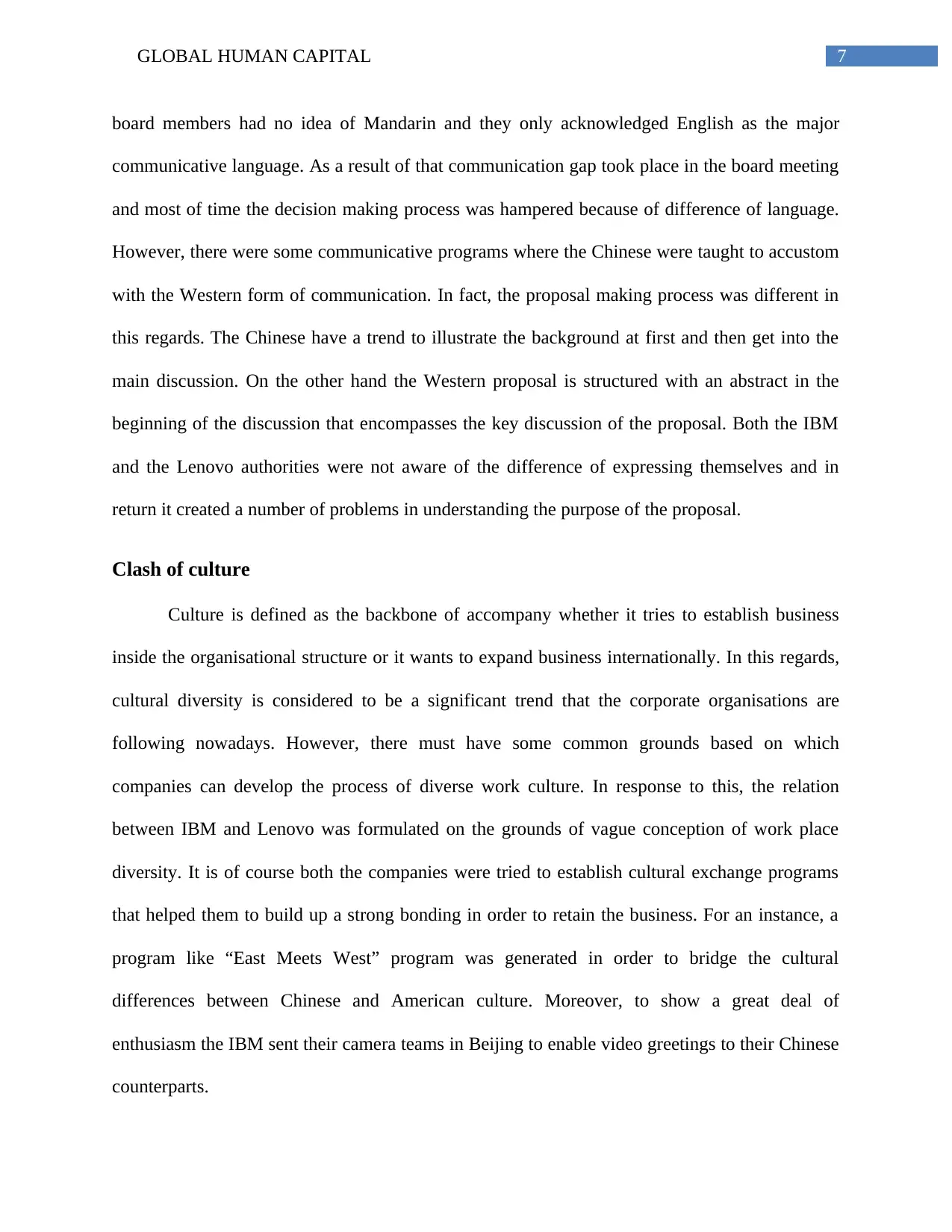
7GLOBAL HUMAN CAPITAL
board members had no idea of Mandarin and they only acknowledged English as the major
communicative language. As a result of that communication gap took place in the board meeting
and most of time the decision making process was hampered because of difference of language.
However, there were some communicative programs where the Chinese were taught to accustom
with the Western form of communication. In fact, the proposal making process was different in
this regards. The Chinese have a trend to illustrate the background at first and then get into the
main discussion. On the other hand the Western proposal is structured with an abstract in the
beginning of the discussion that encompasses the key discussion of the proposal. Both the IBM
and the Lenovo authorities were not aware of the difference of expressing themselves and in
return it created a number of problems in understanding the purpose of the proposal.
Clash of culture
Culture is defined as the backbone of accompany whether it tries to establish business
inside the organisational structure or it wants to expand business internationally. In this regards,
cultural diversity is considered to be a significant trend that the corporate organisations are
following nowadays. However, there must have some common grounds based on which
companies can develop the process of diverse work culture. In response to this, the relation
between IBM and Lenovo was formulated on the grounds of vague conception of work place
diversity. It is of course both the companies were tried to establish cultural exchange programs
that helped them to build up a strong bonding in order to retain the business. For an instance, a
program like “East Meets West” program was generated in order to bridge the cultural
differences between Chinese and American culture. Moreover, to show a great deal of
enthusiasm the IBM sent their camera teams in Beijing to enable video greetings to their Chinese
counterparts.
board members had no idea of Mandarin and they only acknowledged English as the major
communicative language. As a result of that communication gap took place in the board meeting
and most of time the decision making process was hampered because of difference of language.
However, there were some communicative programs where the Chinese were taught to accustom
with the Western form of communication. In fact, the proposal making process was different in
this regards. The Chinese have a trend to illustrate the background at first and then get into the
main discussion. On the other hand the Western proposal is structured with an abstract in the
beginning of the discussion that encompasses the key discussion of the proposal. Both the IBM
and the Lenovo authorities were not aware of the difference of expressing themselves and in
return it created a number of problems in understanding the purpose of the proposal.
Clash of culture
Culture is defined as the backbone of accompany whether it tries to establish business
inside the organisational structure or it wants to expand business internationally. In this regards,
cultural diversity is considered to be a significant trend that the corporate organisations are
following nowadays. However, there must have some common grounds based on which
companies can develop the process of diverse work culture. In response to this, the relation
between IBM and Lenovo was formulated on the grounds of vague conception of work place
diversity. It is of course both the companies were tried to establish cultural exchange programs
that helped them to build up a strong bonding in order to retain the business. For an instance, a
program like “East Meets West” program was generated in order to bridge the cultural
differences between Chinese and American culture. Moreover, to show a great deal of
enthusiasm the IBM sent their camera teams in Beijing to enable video greetings to their Chinese
counterparts.
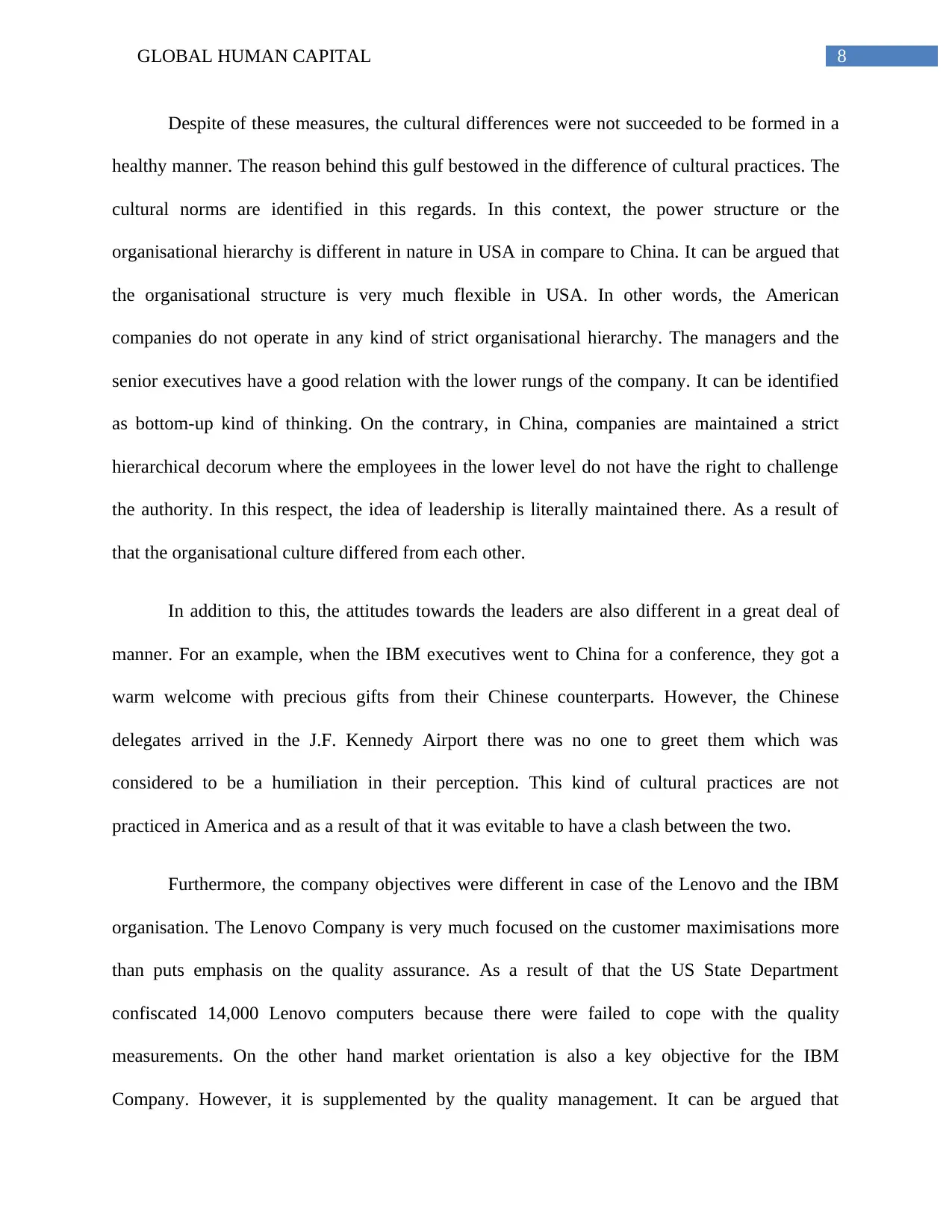
8GLOBAL HUMAN CAPITAL
Despite of these measures, the cultural differences were not succeeded to be formed in a
healthy manner. The reason behind this gulf bestowed in the difference of cultural practices. The
cultural norms are identified in this regards. In this context, the power structure or the
organisational hierarchy is different in nature in USA in compare to China. It can be argued that
the organisational structure is very much flexible in USA. In other words, the American
companies do not operate in any kind of strict organisational hierarchy. The managers and the
senior executives have a good relation with the lower rungs of the company. It can be identified
as bottom-up kind of thinking. On the contrary, in China, companies are maintained a strict
hierarchical decorum where the employees in the lower level do not have the right to challenge
the authority. In this respect, the idea of leadership is literally maintained there. As a result of
that the organisational culture differed from each other.
In addition to this, the attitudes towards the leaders are also different in a great deal of
manner. For an example, when the IBM executives went to China for a conference, they got a
warm welcome with precious gifts from their Chinese counterparts. However, the Chinese
delegates arrived in the J.F. Kennedy Airport there was no one to greet them which was
considered to be a humiliation in their perception. This kind of cultural practices are not
practiced in America and as a result of that it was evitable to have a clash between the two.
Furthermore, the company objectives were different in case of the Lenovo and the IBM
organisation. The Lenovo Company is very much focused on the customer maximisations more
than puts emphasis on the quality assurance. As a result of that the US State Department
confiscated 14,000 Lenovo computers because there were failed to cope with the quality
measurements. On the other hand market orientation is also a key objective for the IBM
Company. However, it is supplemented by the quality management. It can be argued that
Despite of these measures, the cultural differences were not succeeded to be formed in a
healthy manner. The reason behind this gulf bestowed in the difference of cultural practices. The
cultural norms are identified in this regards. In this context, the power structure or the
organisational hierarchy is different in nature in USA in compare to China. It can be argued that
the organisational structure is very much flexible in USA. In other words, the American
companies do not operate in any kind of strict organisational hierarchy. The managers and the
senior executives have a good relation with the lower rungs of the company. It can be identified
as bottom-up kind of thinking. On the contrary, in China, companies are maintained a strict
hierarchical decorum where the employees in the lower level do not have the right to challenge
the authority. In this respect, the idea of leadership is literally maintained there. As a result of
that the organisational culture differed from each other.
In addition to this, the attitudes towards the leaders are also different in a great deal of
manner. For an example, when the IBM executives went to China for a conference, they got a
warm welcome with precious gifts from their Chinese counterparts. However, the Chinese
delegates arrived in the J.F. Kennedy Airport there was no one to greet them which was
considered to be a humiliation in their perception. This kind of cultural practices are not
practiced in America and as a result of that it was evitable to have a clash between the two.
Furthermore, the company objectives were different in case of the Lenovo and the IBM
organisation. The Lenovo Company is very much focused on the customer maximisations more
than puts emphasis on the quality assurance. As a result of that the US State Department
confiscated 14,000 Lenovo computers because there were failed to cope with the quality
measurements. On the other hand market orientation is also a key objective for the IBM
Company. However, it is supplemented by the quality management. It can be argued that
⊘ This is a preview!⊘
Do you want full access?
Subscribe today to unlock all pages.

Trusted by 1+ million students worldwide
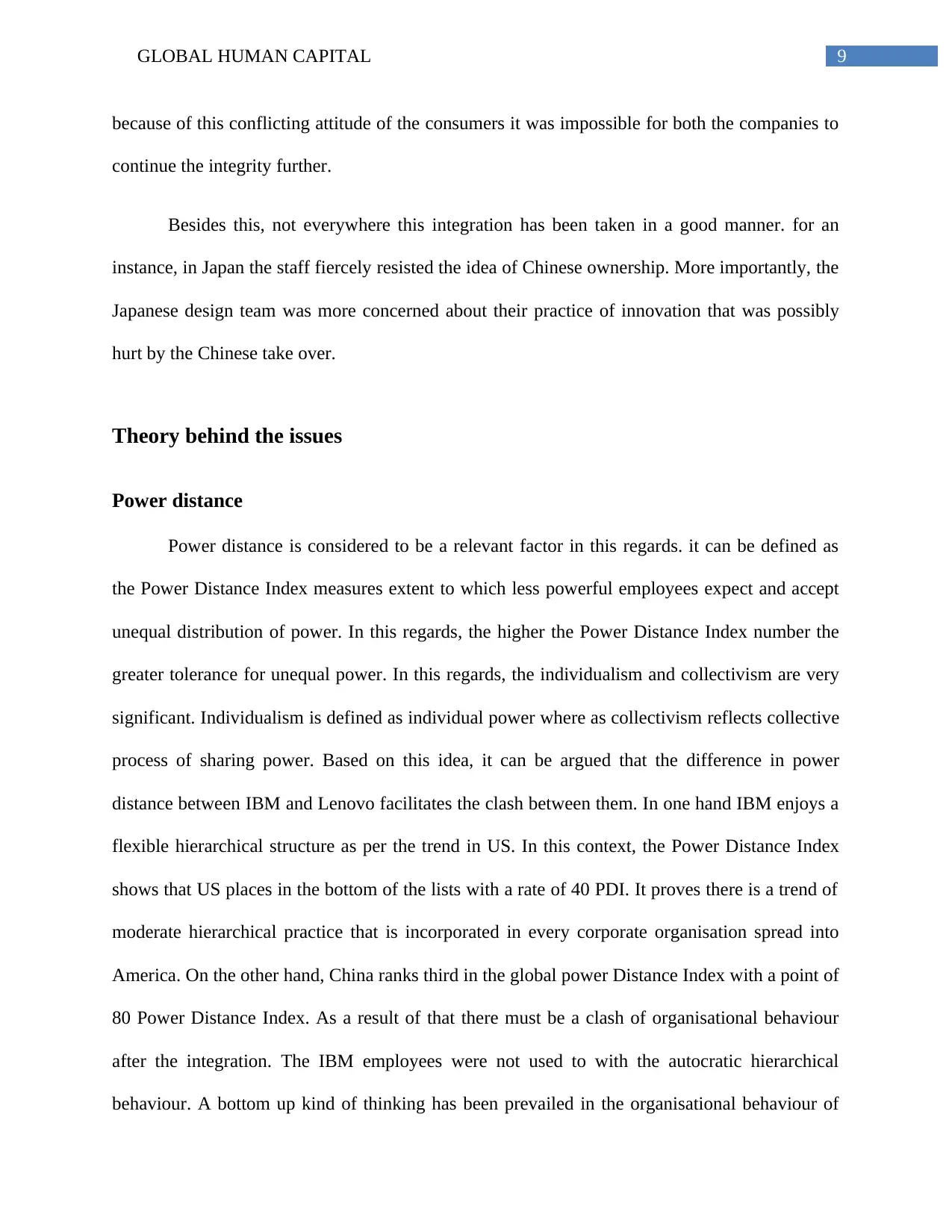
9GLOBAL HUMAN CAPITAL
because of this conflicting attitude of the consumers it was impossible for both the companies to
continue the integrity further.
Besides this, not everywhere this integration has been taken in a good manner. for an
instance, in Japan the staff fiercely resisted the idea of Chinese ownership. More importantly, the
Japanese design team was more concerned about their practice of innovation that was possibly
hurt by the Chinese take over.
Theory behind the issues
Power distance
Power distance is considered to be a relevant factor in this regards. it can be defined as
the Power Distance Index measures extent to which less powerful employees expect and accept
unequal distribution of power. In this regards, the higher the Power Distance Index number the
greater tolerance for unequal power. In this regards, the individualism and collectivism are very
significant. Individualism is defined as individual power where as collectivism reflects collective
process of sharing power. Based on this idea, it can be argued that the difference in power
distance between IBM and Lenovo facilitates the clash between them. In one hand IBM enjoys a
flexible hierarchical structure as per the trend in US. In this context, the Power Distance Index
shows that US places in the bottom of the lists with a rate of 40 PDI. It proves there is a trend of
moderate hierarchical practice that is incorporated in every corporate organisation spread into
America. On the other hand, China ranks third in the global power Distance Index with a point of
80 Power Distance Index. As a result of that there must be a clash of organisational behaviour
after the integration. The IBM employees were not used to with the autocratic hierarchical
behaviour. A bottom up kind of thinking has been prevailed in the organisational behaviour of
because of this conflicting attitude of the consumers it was impossible for both the companies to
continue the integrity further.
Besides this, not everywhere this integration has been taken in a good manner. for an
instance, in Japan the staff fiercely resisted the idea of Chinese ownership. More importantly, the
Japanese design team was more concerned about their practice of innovation that was possibly
hurt by the Chinese take over.
Theory behind the issues
Power distance
Power distance is considered to be a relevant factor in this regards. it can be defined as
the Power Distance Index measures extent to which less powerful employees expect and accept
unequal distribution of power. In this regards, the higher the Power Distance Index number the
greater tolerance for unequal power. In this regards, the individualism and collectivism are very
significant. Individualism is defined as individual power where as collectivism reflects collective
process of sharing power. Based on this idea, it can be argued that the difference in power
distance between IBM and Lenovo facilitates the clash between them. In one hand IBM enjoys a
flexible hierarchical structure as per the trend in US. In this context, the Power Distance Index
shows that US places in the bottom of the lists with a rate of 40 PDI. It proves there is a trend of
moderate hierarchical practice that is incorporated in every corporate organisation spread into
America. On the other hand, China ranks third in the global power Distance Index with a point of
80 Power Distance Index. As a result of that there must be a clash of organisational behaviour
after the integration. The IBM employees were not used to with the autocratic hierarchical
behaviour. A bottom up kind of thinking has been prevailed in the organisational behaviour of
Paraphrase This Document
Need a fresh take? Get an instant paraphrase of this document with our AI Paraphraser
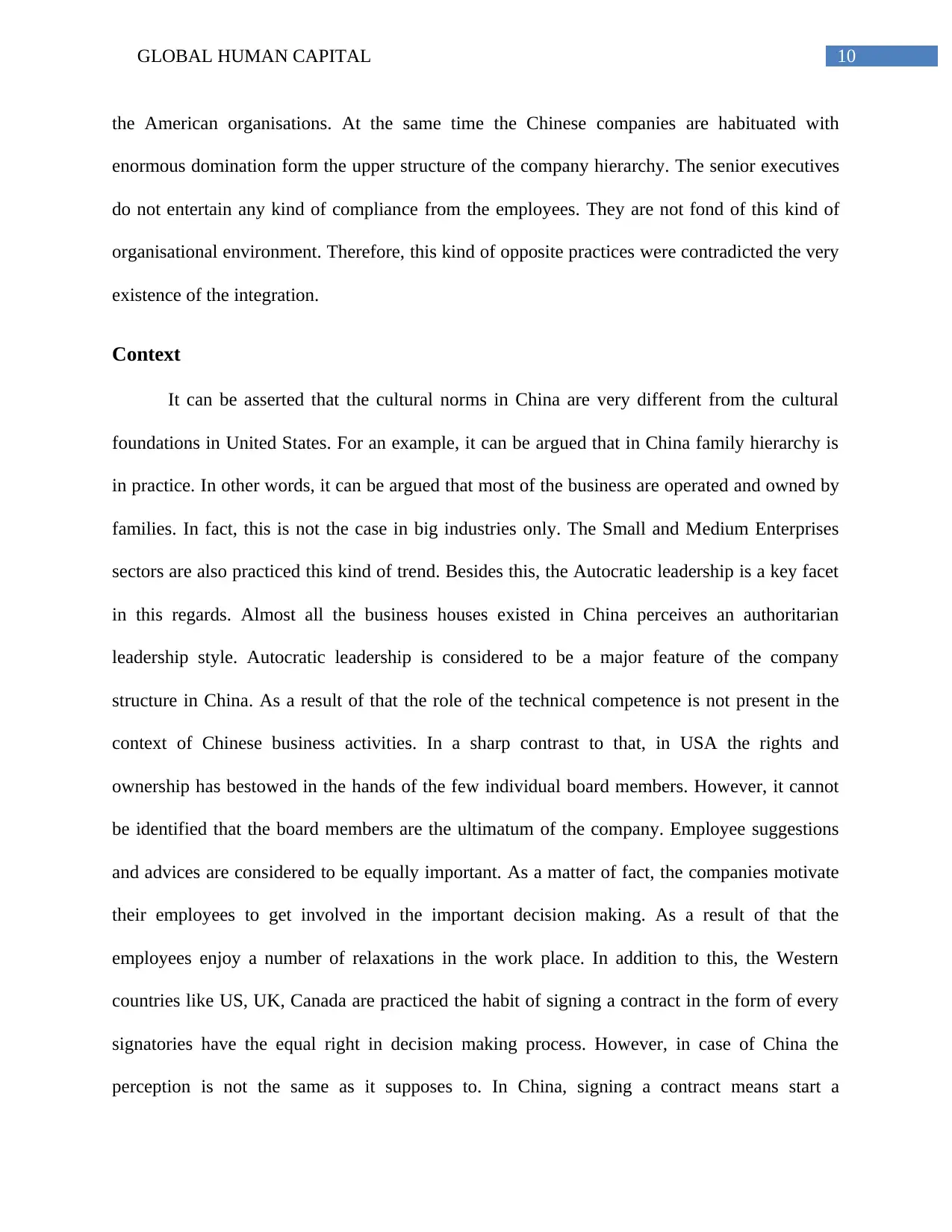
10GLOBAL HUMAN CAPITAL
the American organisations. At the same time the Chinese companies are habituated with
enormous domination form the upper structure of the company hierarchy. The senior executives
do not entertain any kind of compliance from the employees. They are not fond of this kind of
organisational environment. Therefore, this kind of opposite practices were contradicted the very
existence of the integration.
Context
It can be asserted that the cultural norms in China are very different from the cultural
foundations in United States. For an example, it can be argued that in China family hierarchy is
in practice. In other words, it can be argued that most of the business are operated and owned by
families. In fact, this is not the case in big industries only. The Small and Medium Enterprises
sectors are also practiced this kind of trend. Besides this, the Autocratic leadership is a key facet
in this regards. Almost all the business houses existed in China perceives an authoritarian
leadership style. Autocratic leadership is considered to be a major feature of the company
structure in China. As a result of that the role of the technical competence is not present in the
context of Chinese business activities. In a sharp contrast to that, in USA the rights and
ownership has bestowed in the hands of the few individual board members. However, it cannot
be identified that the board members are the ultimatum of the company. Employee suggestions
and advices are considered to be equally important. As a matter of fact, the companies motivate
their employees to get involved in the important decision making. As a result of that the
employees enjoy a number of relaxations in the work place. In addition to this, the Western
countries like US, UK, Canada are practiced the habit of signing a contract in the form of every
signatories have the equal right in decision making process. However, in case of China the
perception is not the same as it supposes to. In China, signing a contract means start a
the American organisations. At the same time the Chinese companies are habituated with
enormous domination form the upper structure of the company hierarchy. The senior executives
do not entertain any kind of compliance from the employees. They are not fond of this kind of
organisational environment. Therefore, this kind of opposite practices were contradicted the very
existence of the integration.
Context
It can be asserted that the cultural norms in China are very different from the cultural
foundations in United States. For an example, it can be argued that in China family hierarchy is
in practice. In other words, it can be argued that most of the business are operated and owned by
families. In fact, this is not the case in big industries only. The Small and Medium Enterprises
sectors are also practiced this kind of trend. Besides this, the Autocratic leadership is a key facet
in this regards. Almost all the business houses existed in China perceives an authoritarian
leadership style. Autocratic leadership is considered to be a major feature of the company
structure in China. As a result of that the role of the technical competence is not present in the
context of Chinese business activities. In a sharp contrast to that, in USA the rights and
ownership has bestowed in the hands of the few individual board members. However, it cannot
be identified that the board members are the ultimatum of the company. Employee suggestions
and advices are considered to be equally important. As a matter of fact, the companies motivate
their employees to get involved in the important decision making. As a result of that the
employees enjoy a number of relaxations in the work place. In addition to this, the Western
countries like US, UK, Canada are practiced the habit of signing a contract in the form of every
signatories have the equal right in decision making process. However, in case of China the
perception is not the same as it supposes to. In China, signing a contract means start a
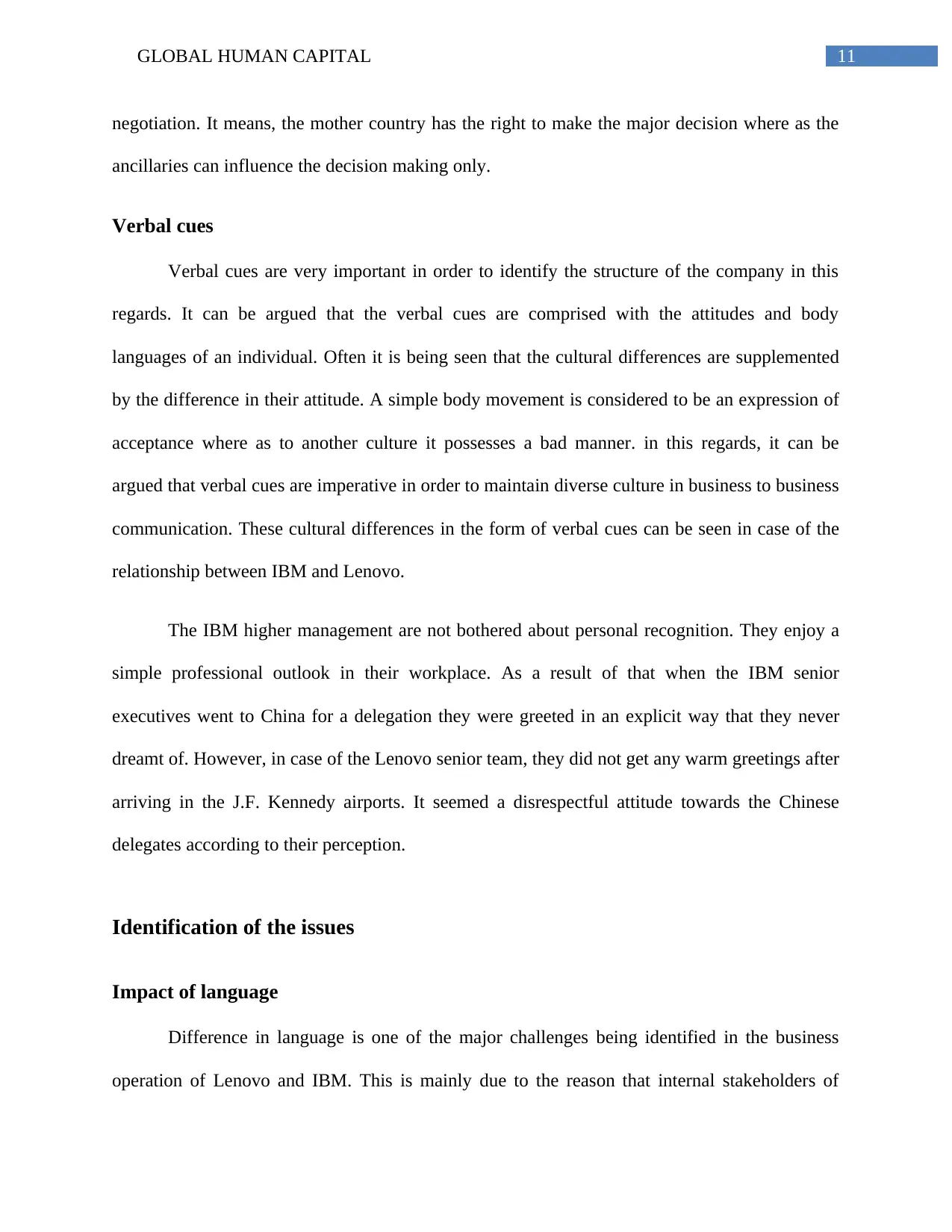
11GLOBAL HUMAN CAPITAL
negotiation. It means, the mother country has the right to make the major decision where as the
ancillaries can influence the decision making only.
Verbal cues
Verbal cues are very important in order to identify the structure of the company in this
regards. It can be argued that the verbal cues are comprised with the attitudes and body
languages of an individual. Often it is being seen that the cultural differences are supplemented
by the difference in their attitude. A simple body movement is considered to be an expression of
acceptance where as to another culture it possesses a bad manner. in this regards, it can be
argued that verbal cues are imperative in order to maintain diverse culture in business to business
communication. These cultural differences in the form of verbal cues can be seen in case of the
relationship between IBM and Lenovo.
The IBM higher management are not bothered about personal recognition. They enjoy a
simple professional outlook in their workplace. As a result of that when the IBM senior
executives went to China for a delegation they were greeted in an explicit way that they never
dreamt of. However, in case of the Lenovo senior team, they did not get any warm greetings after
arriving in the J.F. Kennedy airports. It seemed a disrespectful attitude towards the Chinese
delegates according to their perception.
Identification of the issues
Impact of language
Difference in language is one of the major challenges being identified in the business
operation of Lenovo and IBM. This is mainly due to the reason that internal stakeholders of
negotiation. It means, the mother country has the right to make the major decision where as the
ancillaries can influence the decision making only.
Verbal cues
Verbal cues are very important in order to identify the structure of the company in this
regards. It can be argued that the verbal cues are comprised with the attitudes and body
languages of an individual. Often it is being seen that the cultural differences are supplemented
by the difference in their attitude. A simple body movement is considered to be an expression of
acceptance where as to another culture it possesses a bad manner. in this regards, it can be
argued that verbal cues are imperative in order to maintain diverse culture in business to business
communication. These cultural differences in the form of verbal cues can be seen in case of the
relationship between IBM and Lenovo.
The IBM higher management are not bothered about personal recognition. They enjoy a
simple professional outlook in their workplace. As a result of that when the IBM senior
executives went to China for a delegation they were greeted in an explicit way that they never
dreamt of. However, in case of the Lenovo senior team, they did not get any warm greetings after
arriving in the J.F. Kennedy airports. It seemed a disrespectful attitude towards the Chinese
delegates according to their perception.
Identification of the issues
Impact of language
Difference in language is one of the major challenges being identified in the business
operation of Lenovo and IBM. This is mainly due to the reason that internal stakeholders of
⊘ This is a preview!⊘
Do you want full access?
Subscribe today to unlock all pages.

Trusted by 1+ million students worldwide
1 out of 19
Related Documents
Your All-in-One AI-Powered Toolkit for Academic Success.
+13062052269
info@desklib.com
Available 24*7 on WhatsApp / Email
![[object Object]](/_next/static/media/star-bottom.7253800d.svg)
Unlock your academic potential
Copyright © 2020–2025 A2Z Services. All Rights Reserved. Developed and managed by ZUCOL.





